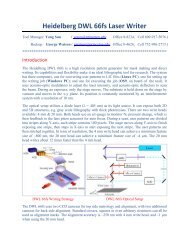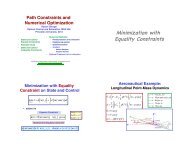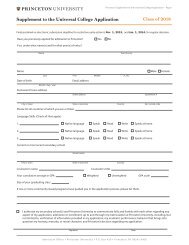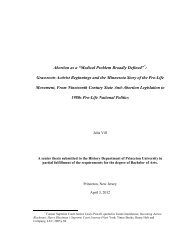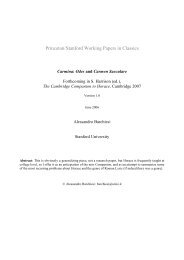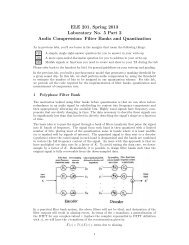By Mark Davis in RISK Magazine - Princeton University
By Mark Davis in RISK Magazine - Princeton University
By Mark Davis in RISK Magazine - Princeton University
You also want an ePaper? Increase the reach of your titles
YUMPU automatically turns print PDFs into web optimized ePapers that Google loves.
They start with the Ornste<strong>in</strong>-Uhlenbeck process, a mean-revert<strong>in</strong>g Gaussian<br />
process Y t satisfy<strong>in</strong>g the SDE<br />
dY t = α(m − Y t )dt + βdW t , (1)<br />
where W t is Brownian motion. This is an asymptotically stationary process,<br />
whose stationary distribution is N(m, β 2 /2α) (the normal distribution with<br />
mean m and variance b 2 /2a, density function φ(y).) Further, it is ergodic,<br />
<strong>in</strong> that ‘time average = ensemble average’. This means that if we take a (say<br />
bounded) function f then<br />
∫<br />
1 T<br />
∫<br />
f(Y t )dt →<br />
T 0<br />
f(y)φ(y)dy as T → ∞ (2)<br />
The parameter α controls the speed of convergence to the stationary distribution.<br />
Indeed, <strong>in</strong>creas<strong>in</strong>g α is equivalent to speed<strong>in</strong>g up the process, so if we<br />
<strong>in</strong>crease α while keep<strong>in</strong>g the stationary variance β 2 /2α constant then the <strong>in</strong>tegral<br />
on the left of (2) keep<strong>in</strong>g T fixed will converge to the average on the<br />
right. Suppose we now let σ 2 (t) = f(Y t ) be the stochastic volatility <strong>in</strong> our<br />
price model. Then the <strong>in</strong>tegral on the left of (2) is just the average realized<br />
variance over the <strong>in</strong>terval [0,T]. If α is very large this is effectively constant,<br />
and we are back to Black-Scholes. The central argument of FPS is that <strong>in</strong> reality<br />
α is large but not <strong>in</strong>f<strong>in</strong>itely large, so we can treat the stochastic volatility<br />
model as a small perturbation from Black-Scholes, which can be quantified by<br />
an asymptotic expansion.<br />
The bottom l<strong>in</strong>e is a corrected pric<strong>in</strong>g formula giv<strong>in</strong>g the option price P as<br />
P = P 0 − P 1 where P 0 is the Black-Scholes price based on long-run average<br />
volatility and the correction P 1 is given by<br />
(<br />
)<br />
(T − t) V 2 x 2 P (2)<br />
0 + V 3 x 3 P (3)<br />
0 .<br />
Here P (2)<br />
0 , P (3)<br />
0 are the second and third derivatives with respect to price (so<br />
P (2)<br />
0 is the option gamma). This is <strong>in</strong>itially derived from the stochastic vol<br />
model (1), but the authors po<strong>in</strong>t out that the formula is universal <strong>in</strong> that a<br />
wide range of vol models lead to exactly the same formula, albeit with different<br />
V 2 , V 3 . These parameters can be used to calibrate the model to a given implied<br />
volatility surface by a simple procedure. There is also an associated hedg<strong>in</strong>g<br />
strategy based, roughly speak<strong>in</strong>g, on delta hedg<strong>in</strong>g with the corrected price. As<br />
FPS po<strong>in</strong>t out this hedg<strong>in</strong>g strategy is not self-f<strong>in</strong>anc<strong>in</strong>g, but it is a ‘m<strong>in</strong>imum<br />
variance’ strategy. Applications to exotic options and to <strong>in</strong>terest rate cont<strong>in</strong>gent<br />
claims are also developed.<br />
Have FPS cracked the stochastic volatility problem? Not really, but they<br />
have certa<strong>in</strong>ly provided an <strong>in</strong>novative approach that merits attention and complements<br />
the methods listed above. The approach is applicable to pric<strong>in</strong>g and<br />
hedg<strong>in</strong>g but not to VaR analysis. Pric<strong>in</strong>g is relatively benign <strong>in</strong> that the calibration<br />
process tends to wash out the differences between models except <strong>in</strong><br />
the case of really sensitive exotics. In hedg<strong>in</strong>g, it is very hard to establish that<br />
any method of volatility prediction is consistently superior <strong>in</strong> terms of portfolio<br />
hedge performance us<strong>in</strong>g historical price and implied vol data. It rema<strong>in</strong>s to be<br />
seen how the FPS method stacks up <strong>in</strong> this respect.<br />
2





